
Advertising & Brands
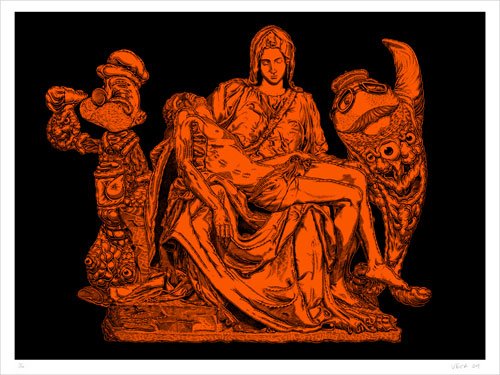
Mark Dean Veca My Mary Silkscreen Print by Mark Dean Veca
My Mary 2-Color Hand-Pulled Limited Edition Silkscreen Print on Fine Art Paper by Mark Dean Veca Rare Street Art Famous Pop Artwork Artist.
$518.00$440.00
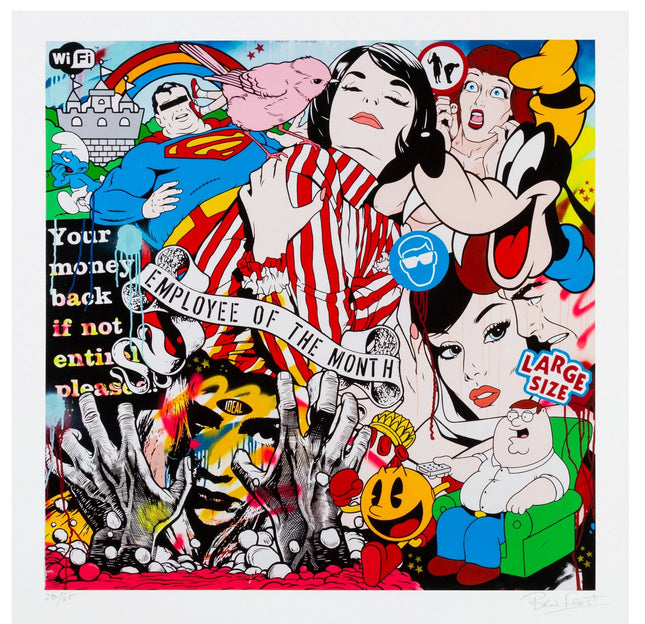
Ben Frost Employee of the Month Archival Print by Ben Frost
Employee of the Month Limited Edition Archival Pigment Fine Art Prints on Fine Art Paper by Graffiti Street Art and Pop Culture Artist Ben Frost. Ben Frost (b. 1975) Employee of the Month, 2014 Archival pigment print on Fine Art paper 17 x 17 inches (43.2 x 43.2 cm) (sheet) Ed. 28/65 Signed and numbered in pencil along the lower edge and published by 1xRUN, Detroit. Visual Dissection of Pop Culture "Employee of the Month" by Ben Frost is a limited edition archival pigment print that dissects and reassembles the fabric of pop culture within the context of street art and graffiti. This piece, created in 2014 and published by 1xRUN in Detroit, is a visually rich tapestry, infusing iconic imagery with subversive undertones characteristic of Frost's work. The print, measuring 17 x 17 inches, is a potent example of how street pop art and graffiti artwork can infiltrate the fine art world with its pulsating energy and color. Born in 1975, Frost has become known for his vibrant visuals that often incorporate elements from cartoons, advertising, and iconic brand imagery. "Employee of the Month" is no exception, featuring an amalgamation of figures from different realms of popular media. These images are not merely placed together but interwoven to create a narrative that speaks to the artist's and the viewer's shared cultural experiences. Subversion and Satire in Ben Frost's Art Frost's piece is a satirical nod to the recognition and rewards system prevalent in corporate culture, highlighted by the badge "Employee of the Month" amidst the chaotic backdrop of consumerist icons. The artwork delves into the themes of identity and recognition in a world saturated with branding and marketing messages. Each character and symbol is meticulously chosen to reflect the absurdity and sometimes the emptiness that can accompany the pursuit of accolades in a capitalist society. The print is signed and numbered by Frost, making each of the 65 editions a collectible piece of art. His signature not only authenticates the work but also marks it as an integral component of his artistic narrative, which often challenges the viewer to reconsider their relationship with the pervasive imagery of consumer culture. Interplay of Street Art and Archival Quality The use of archival pigment on fine art paper is a statement of the permanence Frost wishes to impart to his otherwise fleeting and ephemeral subject matter. While street art is often transient, the archival quality of these prints ensures that the vibrancy and message of the artwork endure. This duality mirrors street art and graffiti's short yet impactful nature – temporary in form but permanent in cultural impact. In summary, Ben Frost's "Employee of the Month" combines street art sensibilities and acceptable art practices, celebrating pop culture through a critical and often irreverent lens. This print stands as a testament to Frost's ability to create art that is both accessible and complex, offering a multifaceted critique of the world we navigate daily. Through his work, Frost continues to push the boundaries of street pop art and graffiti artwork, ensuring these genres' vital place within contemporary art discourse.
$1,230.00
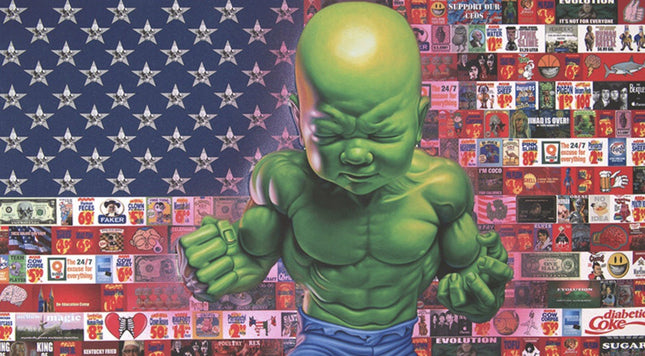
Ron English All-American Temper Tot HPM Embellished Giclee Print by Ron English
All-American Temper Tot Artwork Giclee w/ HPM Airbrush Spray Paint Embleshment Limited Edition Print on Fine Art Paper by Pop Culture Graffiti Artist Ron English. Hand-painted multiple with airbrush spray embellishment around the Hulk-like Temper Tot. Created to celebrate the mural that Ron created on the Houston Bowery Wall in NYC.
$394.00
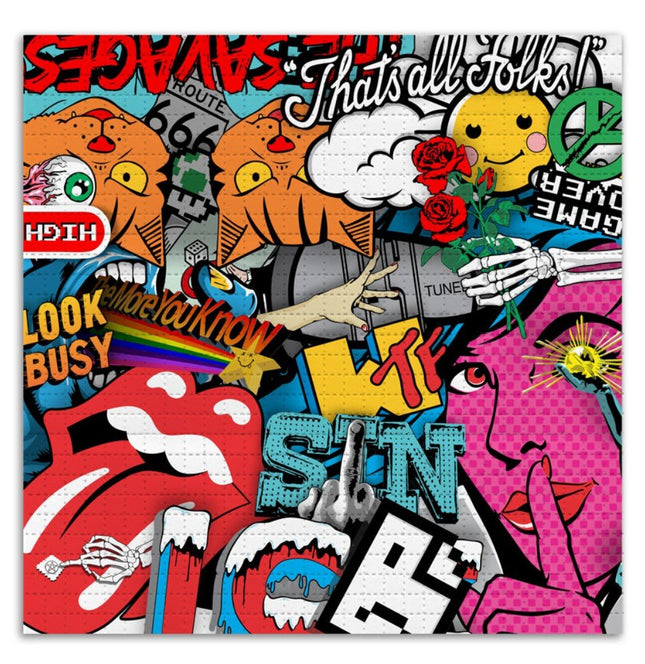
Denial- Daniel Bombardier I See What You Did There Blotter Paper Archival Print by Denial- Daniel Bombardier
I See What You Did There Blotter Paper Limited Edition Archival Pigment Print Art on Perforated Blotter Paper by Denial pop culture LSD artwork. 2021 Signed Limited Edition of 50 Artwork Size 7.5x7.5 Archival Pigment Print on Perforated Blotter Paper Size: 7.5 x 7.5 Inches Release: April 19, 2021. Limited blotter editions are hand-perforated by Zane Kesey & may vary slightly from the example shown. Denial’s art is strongly political and social since the artist takes specific positions against issues, such as capitalism, consumer culture, and advertisements. More importantly, the artist is aware of his choices and motivations: “I like to think of myself as activist pop art. How I relate with cartoons and graphics is a lot easier than I do with photo-realistic stuff" Another aspect of Denial's work is humor. His work is satirical, which, by definition, means that it uses humor as a confronting mechanism.
$422.00
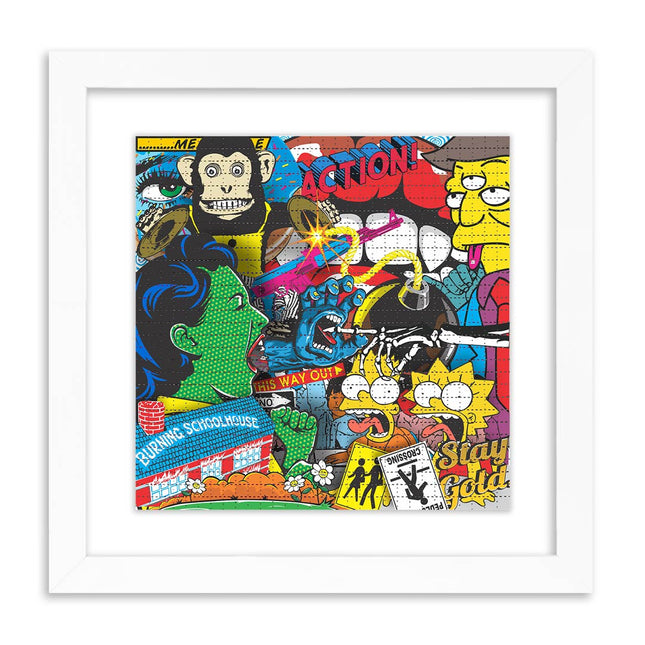
Denial- Daniel Bombardier LSDelinquent Blotter Paper Archival Print by Denial- Daniel Bombardier
LSDelinquent Blotter Paper Limited Edition Archival Pigment Print Art on Perforated Blotter Paper by Denial pop culture LSD artwork. 2019 Signed Limited Edition of 50 Artwork Size 7.5x7.5 In 2000 he adopted the moniker ‘DENIAL’ as a means of poking fun at advertising, politics, and media messages that contemporary society is often ‘in denial about. Since then he has maintained an ongoing global street-campaign of over 500, 000 stickers, placards, and murals, using the alpha-numeric characters ‘D3N!@L’. Intended as a conceptual means of marketing absurdism, DENIAL also challenges traditional notions of graffiti and public art through his bold and often satirical visual subversions. Denial’s art is strongly political and social since the artist takes specific positions against issues, such as capitalism, consumer culture, and advertisements. More importantly, the artist is aware of his choices and motivations: “I like to think of myself as activist pop art. How I relate with cartoons and graphics is a lot easier than I do with photo-realistic stuff" Another aspect of Denial's work is humor. His work is satirical, which, by definition, means that it uses humor as a confronting mechanism.
$422.00
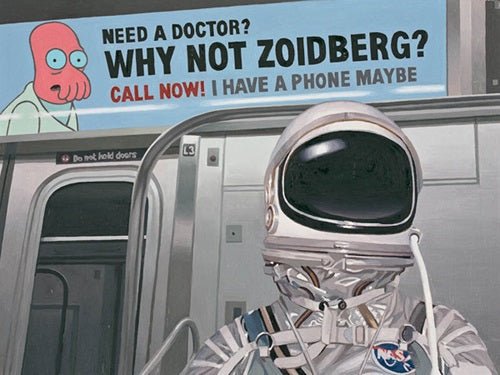
Scott Listfield Why Not Zoidberg? Archival Print by Scott Listfield
Why Not Zoidberg? Artwork Giclee Limited Edition Print on Fine Art Paper by Pop Culture Graffiti Artist Scott Listfield.
$415.00







